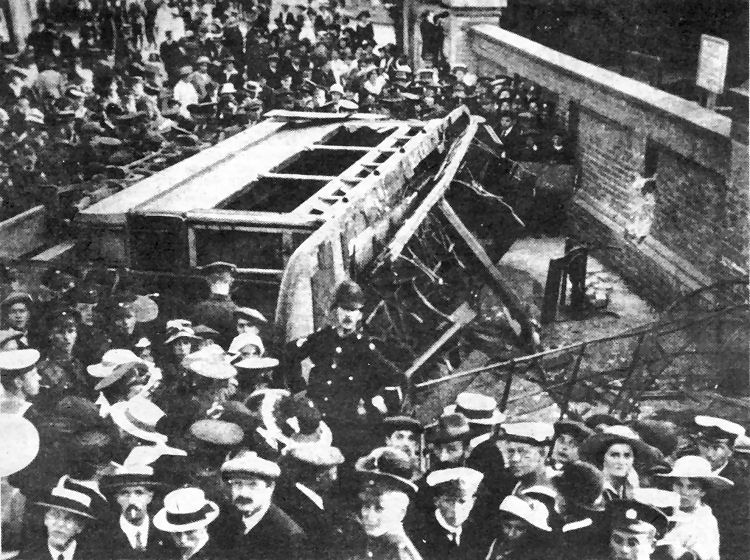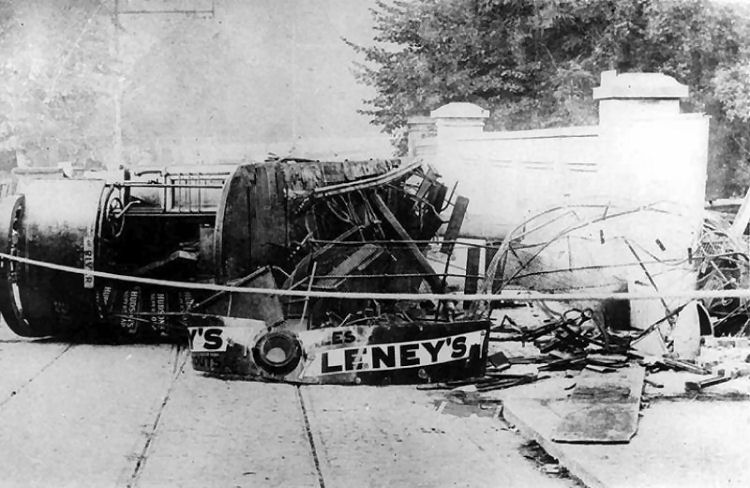Page Updated:- Sunday, 07 March, 2021. |
|||||
 Published in the Dover Express, 12 December, 1980. A PERAMBULATION OF THE TOWN, PORT AND FORTRESS. PART 139.
CONSTRUCTION WORK It does not seem to have been recorded when work began on laying the track for the tramway but early in March, 1897, 700 tons of rails arrived at the port in the Pearl and construction work on the main line began early in the year. Gauge of the track was 3ft 6ins. The original rolling stock consisted of ten passenger cars, two of which, at first, were motorless trailers but were later motorised. They were four-wheel double-deck tramcars with open top decks and almost completely unsheltered platforms. Suppliers were Dick, Kerr & Co. Ltd., but they had Peck-ham chassis from America and bodies made by Brush Electrical Engineering Co.. Ltd. The cars were 15ft long and 6ft wide with five windows on each side. Inward facing seats for 10 passengers were fitted on each side, upholstered in red Utrecht velvet. There was a low pitch roof and, with woodwork of a dark colour, the interior tended to be a little gloomy. Quarter-turn stairs led to the upper deck which was protected only by advertisement boards at the back, front and sides and a low rail at elbow height, and seated 24 passengers. The weatherproof flap seats were arranged in pairs on the platform side of the cars and singly on the other side with a gangway in between. The trolley standard and Its arm were located to one side. The main colours of these early cars were medium green and ivory. The green panels were lined in gold and at first the title Dover Corporation Tramways was painted in very small letters on the side. The Town crest appeared in a panel below the centre window. Those cars delivered later, between 1920 and 1927, had "Dover Corporation Tramways“ on the side in much larger lettering and were in a new and much improved livery, the medium green giving way to emerald green and panels being lined in gold with floral patterns in each comer. The lettering and tramcar numbers were in gold shaded red. Cars added to the fleet between 1927 and 1933, which were previously in use in West Hartlepool, were painted dark red and ivory. With one exception these cars were retained with this livery. Later arrivals, from Birmingham’s tramway, were m cobalt blue and cream and this livery too was retained so that at one stage there were tramcars running over the Dover system in three different colour schemes. Early cars were fitted with primitive-looking lifeguards at the front and back which added to what some might consider a somewhat antiquated appearance. These were later changed. No destination boards were fitted to the cars for some years since they operated on two self-contained routes but in 1904 small boards were hung on the front of the dash and some River cars carried a small illuminated box alongside the headlamp which, when opened, revealed the name River in black letters. Later destination boxes were fitted where they could be seen more easily by passengers.
COAST TRAMWAY PLAN In the early days of the system there was a scheme to link-up Dover's tramway with Ramsgate on one side and Hastings on the other. The line from Thanet was to meet the Dover system at the Market Square and run over its tracks as far as Maxton where it would be continued up the Folkestone Road to Folkestone and round the coast to Hastings. But following a report by the Borough Engineer the Corporation decided to oppose the project on the grounds that it would interfere with the working of the Dover tramway. The scheme gained little support anywhere and was soon abandoned.
RIVER EXTENSION In 1903 an Order was made for the construction of the “Dover and River Light Railway“ by a company headed by Sir William Crandall, thirteen times mayor of Dover, Robert Tritton, George Clark and Andrew Clark. There was also a plan for a line to St Margaret's Bay with a view to the development of the attractive cliff-top land with high-class homes. Serious unemployment at the end of 1904 led to the Corporation seeking to relieve the situation by launching some project which would provide employment and, at a special meeting on 22nd November, they resolved to take over the powers obtained by the River light railway syndicate and to purchase more cars to operate a service to this growing area.

Part of the massive crowd, many of them soldiers, which gathered at the bottom of Crabble Road in 1917 after Dover’s worst ever traffic accident. Tramcar No. 20 careered down the hill out of control killing 11 passengers and injuring the remainder. The tram, carrying 70 passengers, left the track, demolished a wall on the right, bit another wall and then toppled over, crushing the top deck and shattering most of its windows.

Two of those who died were women, the conductress, Miss Lottie Scrase, of Heathfield Avenue, and Miss Susan Green, of Norman Terrace, who are pictured above.

Another view of the accident spot appears above. 
Above showing a closer view, kindly sent by Paul Wells.
|
|||||
|
If anyone should have any a better picture than any on this page, or think I should add one they have, please email me at the following address:-
|
|||||
| LAST PAGE |
|
MENU PAGE |
|
NEXT PAGE | |